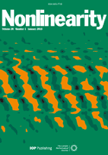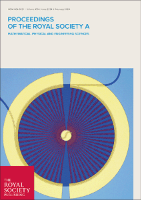
REGULAR & CHAOTIC DYNAMICS
Scope & Guideline
Pioneering Research in Regular and Chaotic Dynamics
Introduction
Aims and Scopes
- Dynamical Systems Theory:
Explores the fundamental principles of dynamical systems, including stability, bifurcations, and chaos. This area often employs analytical and numerical methods to study the behavior of systems over time. - Hamiltonian Dynamics:
Focuses on systems described by Hamiltonian mechanics, emphasizing integrability, chaos, and the geometric structures of phase space. This includes studies on Hamiltonian systems with various constraints and perturbations. - Nonlinear Dynamics and Chaos:
Investigates the behavior of nonlinear systems, with particular attention to chaotic dynamics, attractors, and bifurcations. This area is crucial for understanding complex phenomena in both natural and engineered systems. - Mathematical Physics Applications:
Applies dynamical systems theory to physical problems, including fluid dynamics, celestial mechanics, and statistical mechanics. This approach often bridges mathematics and physics to solve real-world problems. - Numerical Analysis of Dynamical Systems:
Utilizes computational methods to analyze and simulate dynamical systems. This includes numerical experiments to validate theoretical results and explore complex behaviors.
Trending and Emerging
- Complex Systems and Networks:
There is an increasing focus on the dynamics of complex systems and networks, particularly in areas such as synchronization and the interplay of chaotic behaviors in interconnected systems. - Nonholonomic Systems:
Research on nonholonomic systems, which include constraints that depend on the velocities of the system, is becoming more prominent, indicating a growing interest in their unique dynamical properties. - Interdisciplinary Applications:
The journal is witnessing a trend towards interdisciplinary studies that apply dynamical systems theory to diverse fields such as biology (e.g., neuronal dynamics), engineering, and even social sciences, emphasizing the broad applicability of dynamical concepts. - Advanced Numerical Methods and Simulations:
There is a notable increase in the development and application of sophisticated numerical methods to explore chaotic dynamics and bifurcations, highlighting the importance of computational techniques in modern dynamical systems research.
Declining or Waning
- Classical Mechanics Applications:
There seems to be a reduction in studies specifically focused on classical mechanical systems, particularly those that were previously popular, such as simple pendulum dynamics or basic celestial mechanics. - Low-Dimensional Dynamical Systems:
Research on low-dimensional systems, such as two-dimensional maps or simple ordinary differential equations, appears to be less frequent, possibly due to a shift towards more complex, higher-dimensional systems. - Basic Stability Analysis:
Papers focusing solely on elementary stability analysis without a broader context of chaos or bifurcation theory are becoming less common, indicating a shift towards more integrated approaches that combine multiple aspects of dynamical systems.
Similar Journals

DISCRETE AND CONTINUOUS DYNAMICAL SYSTEMS
Bridging theory and practice in mathematical sciences.DISCRETE AND CONTINUOUS DYNAMICAL SYSTEMS is a prestigious academic journal published by the American Institute of Mathematical Sciences (AIMS), dedicated to the dissemination of high-quality research in the fields of Discrete Mathematics, Applied Mathematics, and Dynamical Systems. With an impressive impact factor that places it in the Q1 quartile of several mathematical categories, including an outstanding rank of #20 in Discrete Mathematics and Combinatorics, this journal serves as an essential platform for researchers, professionals, and students to explore innovative methodologies and applications. Since its inception in 1996, the journal has partaken in the convergence of mathematical theories, with its editorial board committed to publishing cutting-edge studies up until 2025. Although it is not open access, the journal's rigorous peer-review process ensures that each article maintains the highest scholastic standards, making it a vital resource in the advancement of mathematical sciences.

Advances in Mathematical Physics
Advancing Knowledge through Open AccessAdvances in Mathematical Physics is a premier open-access journal published by HINDAWI LTD, dedicated to the dissemination of research in the fields of applied mathematics and physics. With its ISSN 1687-9120 and E-ISSN 1687-9139, this journal has been a vital platform for innovative studies since its inception in 2009, fostering a collaborative environment for researchers and professionals alike. The journal features a wide range of topics, including but not limited to mathematical models, computational physics, and interdisciplinary applications, thus attracting a diverse readership. Ranked in the Q3 quartile for both Applied Mathematics and Physics and Astronomy, it serves as a significant resource for academics looking to explore cutting-edge developments and theoretical advancements. With an emphasis on open accessibility, Advances in Mathematical Physics ensures that research findings are readily available to the global academic community, leveling the playing field for emerging scholars and seasoned researchers. By consistently showcasing high-quality manuscripts, the journal contributes substantially to the fields of mathematics and physics, encouraging scholarly dialogue and advancing knowledge across a myriad of applications.

NONLINEARITY
Fostering Innovation in Nonlinear DynamicsNONLINEARITY is a premier academic journal published by IOP Publishing Ltd, dedicated to advancing the field of complex systems through the lens of nonlinear science. Since its inception in 1988, the journal has established itself as a vital resource for researchers and professionals alike, offering a robust platform for disseminating high-quality research in areas such as applied mathematics, mathematical physics, and statistical and nonlinear physics. With an impressive Q1 ranking across multiple pertinent categories, including Applied Mathematics and Mathematical Physics, NONLINEARITY ranks among the top journals globally, making it essential reading for those seeking to deepen their understanding of nonlinear phenomena. Although it does not operate under an open-access model, its rich repository of rigorous articles significantly contributes to academia, fostering innovative thought and facilitating cutting-edge research. Located in the heart of the United Kingdom at TEMPLE CIRCUS, TEMPLE WAY, BRISTOL BS1 6BE, NONLINEARITY continues to be at the forefront of the scientific community, championing new discoveries and interdisciplinary dialogue within its dynamic scope.

Journal of Dynamics and Differential Equations
Pioneering Research in Dynamics and Differential EquationsJournal of Dynamics and Differential Equations, published by SPRINGER, is a premier academic journal dedicated to advancing the understanding of dynamic systems and their mathematical foundations. Operating since its inception in 1989, the journal has become a vital resource for researchers and practitioners in the field, boasting a commendable Q1 ranking in the Analysis category as of 2023 and ranking #39 out of 193 journals in Mathematics Analysis on Scopus, placing it in the 80th percentile. While it maintains a traditional subscription model, its substantial contributions to the mathematics community—measured by a robust impact and adherence to high academic standards—make it essential reading for those engaged in differential equations and dynamical systems. The journal covers a broad scope of theoretical and applied research, positioning itself as a cornerstone for innovative studies and discussions, and ensuring its relevance to both contemporary and future mathematical inquiries.

Nonlinear Phenomena in Complex Systems
Connecting Researchers in Nonlinear DynamicsNonlinear Phenomena in Complex Systems, published by BELARUSSIAN STATE UNIV, JOINT INST POWER & NUCLEAR RESEARCH, is an emerging platform dedicated to advancing the understanding of nonlinear phenomena within complex systems. With an ISSN of 1561-4085 and an E-ISSN of 1817-2458, this journal serves as a vital resource for researchers spanning the fields of mathematical physics and statistical and nonlinear physics. While classified within the Q4 quartile for both disciplines as of 2023, we encourage authors to submit impactful research that addresses the intricacies and challenges presented by complex systems, which are pivotal in various scientific applications. Targeting an international audience, including researchers, professionals, and students, the journal aspires to foster collaboration and innovation by offering open access to its insightful articles. With a converged publication timeline from 2009 to 2024, Nonlinear Phenomena in Complex Systems is poised to become a significant contributor to the evolving dialogue around nonlinear dynamics and their implications across multiple scientific domains.

Izvestiya Vysshikh Uchebnykh Zavedeniy-Prikladnaya Nelineynaya Dinamika
Unlocking Insights in Nonlinear Dynamics and BeyondIzvestiya Vysshikh Uchebnykh Zavedeniy-Prikladnaya Nelineynaya Dinamika, published by Saratov State University, is a distinguished open-access journal that has been contributing to the fields of Applied Mathematics and Physics since its inception in 2005. With an ISSN of 0869-6632 and E-ISSN 2542-1905, this journal fosters the dissemination of innovative research in nonlinear dynamics and statistical physics. Recognized within the academic community, it holds a Q3 ranking in the categories of Applied Mathematics, Physics and Astronomy (miscellaneous), and Statistical and Nonlinear Physics as of 2023. Despite facing competitive environment challenges, with Scopus ranks positioning it in the lower percentiles, the journal remains an important platform for scholars aiming to share insightful findings and theoretical advancements with a global audience. Based in the Russian Federation, it transitioned to an open-access model in 2020, enhancing accessibility and ensuring that cutting-edge research reaches those who can benefit from it most. The journal aspires to continue its trajectory of fostering high-quality scholarship through rigorous peer review and collaboration across disciplines.

INTERNATIONAL JOURNAL OF NON-LINEAR MECHANICS
Unraveling Complexities in MechanicsWelcome to the International Journal of Non-Linear Mechanics, a premier publication dedicated to advancing the understanding of non-linear behavior in mechanical systems. Published by Pergamon-Elsevier Science Ltd, this esteemed journal has been an influential platform since its inception in 1966 and continues its rigorous exploration of specialized topics until 2024. With a strong focus on applied mathematics, mechanical engineering, and mechanics of materials, it holds an impressive Q1 ranking in both mechanical engineering and mechanics of materials, and a Q2 ranking in applied mathematics, underscoring its significance in these fields. Notably, it ranks 81st out of 635 in Applied Mathematics, highlighting its vital contribution to the literature. The journal's commitment to quality research is reflected in its indexing in Scopus and its prominent impact within the academic community. Although not an open access journal, it remains accessible to researchers and professionals seeking cutting-edge innovations and breakthroughs in non-linear mechanics. We invite scholars, practitioners, and students alike to engage with the pivotal research published in this journal as they advance their own works in the dynamic landscape of engineering and applied sciences.

CELESTIAL MECHANICS & DYNAMICAL ASTRONOMY
Charting the Course of Celestial Bodies Through Rigorous ResearchCELESTIAL MECHANICS & DYNAMICAL ASTRONOMY is an esteemed journal published by Springer, dedicated to advancing the field of celestial mechanics, dynamical astronomy, and related disciplines. With an ISSN of 0923-2958 and an E-ISSN of 1572-9478, this journal has been a vital resource since its inception in 1989 and continues to provide invaluable insights up to 2024. Recognized for its impactful research, it holds a Q2 ranking in multiple categories, including Applied Mathematics and Astronomy and Astrophysics, indicating its significance in both academic and practical applications. Researchers and professionals can expect a curated selection of innovative studies that foster a deeper understanding of the dynamics of celestial bodies and the mathematical principles governing them. The journal is committed to maintaining high standards and contributes to interdisciplinary discourse, making it a preferred choice for those engaged in cutting-edge research in astronomy, astrophysics, and computational mathematics.

PROCEEDINGS OF THE ROYAL SOCIETY A-MATHEMATICAL PHYSICAL AND ENGINEERING SCIENCES
Exploring Innovative Research for a Scientific Tomorrow.PROCEEDINGS OF THE ROYAL SOCIETY A-MATHEMATICAL PHYSICAL AND ENGINEERING SCIENCES is a prestigious academic journal published by the Royal Society in the United Kingdom, dedicated to the dissemination of high-quality research in the fields of Mathematics, Engineering, and Physics. With an esteemed impact factor and ranked in the top quartiles (Q1) across various categories, this journal stands out as a leading source of innovative findings and critical discussions within the global scientific community. Researchers benefit from its comprehensive coverage that spans from theoretical explorations to practical applications, and the journal plays a crucial role in advancing knowledge and fostering interdisciplinary collaboration. Although it does not currently offer Open Access options, its influence is underscored by notable Scopus rankings, evidencing its significant contribution to the fields it represents. Located at 6-9 Carlton House Terrace, London SW1Y 5AG, England, the journal continues to be a cornerstone for scholars seeking to publish impactful research and stay informed on the latest advancements in science and engineering.

Journal of Dynamical Systems and Geometric Theories
Advancing the Frontiers of Mathematical UnderstandingJournal of Dynamical Systems and Geometric Theories, published by TARU Publications, is a prominent platform dedicated to advancing knowledge in the fields of dynamical systems and geometric theories. With an ISSN of 1726-037X and an E-ISSN of 2169-0057, this journal serves as a vital resource for researchers, professionals, and students who are keen on exploring the complexities of mathematical models and their applications in various scientific disciplines. Though currently listed as non-open access, the journal provides robust, peer-reviewed content that is essential for fostering innovative research and development. Situated in New Delhi, India, the Journal of Dynamical Systems and Geometric Theories is committed to disseminating high-quality scholarly articles that address both theoretical and practical issues related to dynamical systems, enhancing understanding and stimulating further academic discourse. To learn more about submission guidelines and access options, please visit the journal’s official webpage.